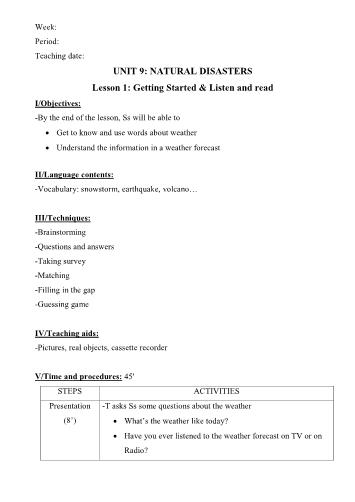Giáo án Tiếng Anh Lớp 9 - Unit 9: Natural disasters
Bạn đang xem tài liệu "Giáo án Tiếng Anh Lớp 9 - Unit 9: Natural disasters", để tải tài liệu gốc về máy hãy click vào nút Download ở trên.
Tóm tắt nội dung tài liệu: Giáo án Tiếng Anh Lớp 9 - Unit 9: Natural disasters

Do you think the weather forecast is useful for us? -T introduces the context and plays the tape -T teaches the new words Turn up (v) (mime) Expect (v) (translation) Thunderstorm (n) (picture) Delta (n) (example) -T asks Ss to repeat individually and chorally Practice (15’) -T asks Ss to practice the dialogue in groups of three -T calls on some students to play the roles of Thuy and her grandmother and the weatherman to practice the dialogue -T has Ss read the dialogue silently and do the task (2b/ 75) -Ss do the task and compare their answers with their friend’s Production -T asks Ss to look at the map which shows the weather of some (10’) provinces and fill in the charts -T corrects the mistakes if there are any -Ss tell the weather of each provinces, base on the forecast Homework (3’) -Ss do exercise 1 (WB/58) and write some sentences about the weather forecast VI/Self - evaluation: Week: Period: Teaching date: UNIT 9: NATURAL DISASTERS Lesson 2: Speak I/Objectives: Practice (20’) -T has Ss do the task/ 36 and explains the expressions of giving opinions and showing agreement -Ss work in pairs and then represent their ideas in front of the class, T corrects the mistakes if there are any Production (11’) -T asks Ss to discuss the questions “What should you do to help your family when there is a typhoon?” Homework (5’) -T asks Ss to make a list of the things we should do to prepare for an earthquake VI/Self – evaluation Week: Period: Teaching date: UNIT 9: NATURAL DISASTERS Lesson 3: Listen I/Objectives: By the end of the lesson, Ss will be able to -get to know some ideas on how to live with earthquake through sentence completion exercises -listen to the talk better, identify and catch key words for the answer-Students listen for specific information to fill in the missing words -Ss will be able to complete the song by filling in the missing words II/Language content: -Vocabulary: earthquake zone III/Techniques: -Brainstorming -Questions and answers Week: Period: Teaching date: UNIT 9: NATURAL DISASTERS Lesson 4: Read I/Objectives: After learning the lesson, Ss may get more information about naturals disasters in the world II/Language content: -Vocabulary: words related to the natural disasters -Grammar: relative pronoun “which” III/Techniques: -Brainstorming -Questions and answers -Completion -Scanning IV/Teaching aids: - OHP -Stereo -A picture of computer V/Time and procedures: 45' VI/Self - evaluation: pre- writing and answer the questions (10’) What are the people doing in each pictures? What do you think of the pitures? -T explains the content of the pictures While- writing -Ss discuss in group of 4 about what to write for their (20’) story. T has Ss present their result on the screen and then corrects the mistakes in there are any. -T reviews the verb tenses: past simple and past progressive Post- writing -T has Ss tell the whole story, using the suggested words (10’) in groups of 4 -T enquires some students to retell the story in front of the class, using the pictures Homework (5’) -T has Ss write the story which they can imagine about the experiences they have had VI/Self – evaluation Week: Period: Teaching date: UNIT 9: NATURAL DISASTERS Lesson 6: Language Focus I/Objectives: 3. May Day is the day when 4. Valentine’s Day is the day when 5. July 4 is the day when 6. Mother’s Day is the day when Presentation -T tells Ss how to identify a relative clause (10’) Relative clauses without comas are called “defining” or “identifying clauses”. They provide essential information about the subject or object Relative clauses with comas are called “non- defining clauses”. They provide additional information, which can be omitted/ removed Practice (13’) -T tells Ss to do exercise 1, join 2 sentences, using relative clauses -T asks Ss to study the pictures in the book and use the relative clause to describe each of the people in the pictures, follow the examples in the book Presentation 2 -Though, although, even though+ clause (these express the (5’) opposite ideas) Practice (5’) -T has Ss do exercise 3, join the sentences, use the words in the brackets. T asks Ss to compare the sentences with their friends Practice (5’) -T tells Ss to do exercise 4, look at the picture to complete the sentences by using “though, although, even though” VI/Self - evaluation
File đính kèm:
 giao_an_tieng_anh_lop_9_unit_9_natural_disasters.pdf
giao_an_tieng_anh_lop_9_unit_9_natural_disasters.pdf